Abstract
The purpose of this article is to analyze the most popular maturity models in order to identify their strengths and weaknesses. Research conducted by international project management communities such as Software Engineering Institute (SEI), Project Management Institute (PMI), International Project Management Association (IPMA), Office of Government Commerce (OGC) and International Organization for Standardization (ISO) showed that organizations with high managerial maturity are more likely to achieve their planned project goals than those that do not identify and standardize their best management practices. This circumstance has encouraged scientists from all over the world to start developing various models that can measure and evaluate managerial maturity in projects. Nowadays, the variety of models created has led to considerable difficulty in understanding the strengths and weaknesses of each model. To solve this problem, the article authors conducted a critical analysis to identify the strengths and weaknesses of the most popular project management maturity models. The results obtained will be of interest to project managers, members of project teams, heads of organizations, project offices and everyone involved in the development of project activities. Based on the analysis, it was found that the most developed maturity models are based on international codes of knowledge of project management. Most maturity models ignore the presence of structural and infrastructural elements, such as a workplace, the necessary equipment and software, the availability of professional standards, instructions, regulations, etc. It was also revealed that there are no processes for assessing the effectiveness and efficiency of using the best practices in the maturity models.
1. Introduction
Project Management Institute (PMI) defines project management as a body of knowledge, skills, tools and technologies that contribute to the full implementation of planned requirements (PMBOK Guide® 2017). The main goal of project management is to successfully achieve project objectives (scope, schedule, cost and quality) and meet all interested parties’ expectations (Sidorov and Senchenko 2020).
Project management is not a new type of activity for people. Over the centuries, many major projects, such as the construction of the Giza Pyramid, the Great Wall of China, the Taj Mahal, the Panama Canal and many others have been implemented. During this time, knowledge of how to manage such projects so that the actual results fully coincide with the planned ones has been accumulated. This knowledge was processed, systematized and consolidated in the best project management practices around the world (PMBOK Guide® 2017; ICB IPMA 2015; PRINCE2® 2017; ISO 2018).
However, it is worth noting that despite the significant development in the field of project management, many projects are still exposed to numerous risks, the materialization of which prevents their successful completion (The Chaos Manifesto 2014). In particular, the results of research conducted by V. S. Nikolaenko indicate that about 105 risks can materialize in any IT project, namely, 5 commercial risks, 45 compliance risks and 55 project risks. It is very important to emphasize that the average damage from one compliance risk materialization costs $12,000 (Nikolaenko 2018; Nikolaenko 2022).
J. K. Crawford claims that frequent risks materialization is a natural indicator that clearly demonstrates the immaturity of project teams and project managers (Crawford 2007).
To solve the problem of eliminating risks, many international project communities (SEI, PMI, IPMA, OGC, ISO, etc.) and leading scientists recommend using project management maturity levels and maturity models (Crawford 2007; Grant and Pennypacker 2006; Backlund et al. 2014; Anderson and Jessen 2003; Meisner 2007; Jugdev and Thomas 2002; Montero 2013). According to the hypothesis stated, in organizations with high managerial maturity, dangerous risks materialize less often, which significantly increases the chances to complete initiated projects successfully.
The revealed connection between project management maturity and the likelihood of successful completion has led to the creation of numerous maturity models. In particular, in their works, K. P. Grant and J. S. Pennypacker claim that about 30 maturity models have already been developed (Grant and Pennypacker 2006). F. Backlund, D. Choronner, E. Sundqvist et al. provide empirical evidence that organizations with a high level of managerial maturity are less likely to materialize dangerous risks (Backlund et al. 2014; Anderson and Jessen 2003; Meisner 2007; Jugdev and Thomas 2002; Montero 2013).
It should be noted that attempts to conduct a comparative analysis of the most popular project management maturity models were made earlier (Khoshgoftar and Osman 2009; Trocki and Buklaha 2016). However, as the critical analysis has shown, previous studies have focused mainly on superficial comparison and the search for conceptual differences between models without specifying their strengths and weaknesses. In this regard, the purpose of this article is to analyze the most popular maturity models, such as The Capability Maturity Model Integration (CMMI®), The Organizational Project Management Maturity Model (OPM3), The International Project Management Association Delta (IPMA DELTA®), The Portfolio, Program and Project Management Maturity Model (P3M3®), The Software Process Improvement and Capability Evaluation (SPICE), The Project Management Process Maturity Model (PM2), The Kerzner Project Management Maturity Model (PMMM), The Project Management Maturity Model (ProMMM) and The PM Solutions Project Management Maturity Model (PMMMsm), in order to identify their strengths and weaknesses.
The analysis of the maturity model’s strengths and weaknesses included the following steps. First, the concept and methodology of applying maturity models were studied. Second, the subject area of application was defined. Third, scientific papers describing the testing of maturity models and presenting the results of implementation were analyzed. Fourth, a comparative analysis to identify strengths and weaknesses for each maturity model was conducted.
2. Conceptual Content of Project Management Maturity Models
2.1. The Capability Maturity Model Integration (CMMI®)
The Capability Maturity Model (CMM) was developed in 1987 as part of the Software Engineering Institute (SEI) project at the Carnegie-Mellon University Research Center (USA). The model was created because the US military and government structures needed a method to evaluate contractors (performers, suppliers) in the field of software development. In 2000, the model was transformed into an integrated Capability Maturity Model Integration (CMMI®) capability maturity model, which allows evaluating not only the maturity of development processes, but also other organization-level processes, including procurement, material support, etc. Since 2006, CMMI® has been separated for 3 models:
- CMMI for Development (CMMI-DEV)—the model is focused on organizations that develop software.
- CMMI for Services (CMMI-SVC)—the model is focused on organizations that provide services.
- CMMI for Acquisition (CMMI-ACQ)—the model is focused on organizations that are engaged in procurement and supply.
Version 1.3 (2010) decomposes all the activities of the organization into 22 processes, where these processes are divided into 4 groups—the process management group, the project management group, the engineering activity group and the support group.
It is worth noting separately that CMMI® offers two independent types of assessment—a power-assessment of the individual processes and an assessment of the organization maturity in general.
When assessing the individual processes power, a scale from 0 to 3 was used (Figure 1). In particular:
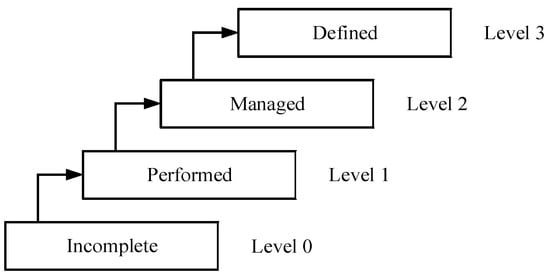
Figure 1.
CMMI® Process Maturity Levels.
- Level 0. Incomplete—the process is missing or only partially running.
- Level 1. Performed—the process is performed but not standardized.
- Level 2. Managed—the process is carried out in accordance with the plan and regulations, controlled and evaluated.
- Level 3. Defined—the process is aligned with other processes in the organization so that a coherent set of processes can be created.
When assessing the organization maturity in general, a scale from one to five was used. The process areas that must be implemented by the organization were identified at each level (Figure 2). For example, to achieve Level 5 (Optimizing), an organization must implement two processes, such as Cause Analysis and Resolution and Organizational Performance Management. The organization maturity model is represented by the following levels:
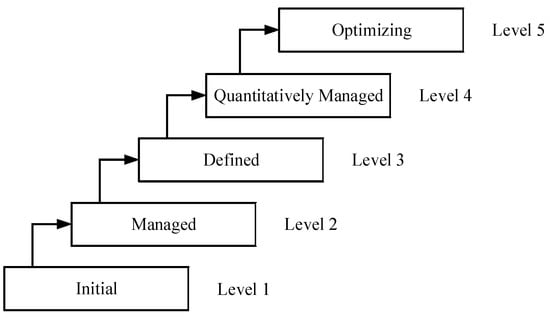
Figure 2.
Organization maturity levels according to CMMI®.
- Level 1. Initial—processes are irregular, there is no systematic approach to software development.
- Level 2. Managed—the organization uses project management methodologies. The processes are well defined, but the maturity levels of the processes can vary greatly between projects.
- Level 3. Defined—processes are defined within a coherent, consistent organization’s process management system.
- Level 4. Quantitatively Managed—processes are measured and controlled quantitatively.
- Level 5. Optimizing—the management focus is on innovation and continuous process improvement.
Version 2.0 was released in March 2018 with significant changes (O’Neill 2018). In particular:
- The division into three models has disappeared. The CMMI® model has become single.
- A structure of 4 layers has been introduced. Specifically, a category layer (Doing, Managing, Enabling and Improving), a categorized feature area layer, the best practice area layer and a feature layer.
- The specification has become closed and paid.
2.2. The Organizational Project Management Maturity Model (OPM3)
The Organizational Project Management Maturity Model (OPM3) development started in 1998 as part of a series of standards produced by the Project Management Institute (PMI). More than 800 volunteer project management practitioners from almost all industries and disciplines from 35 countries actively participated in the research and development of OPM3. The first version of the standard was published in 2003, thereafter PMI received a large amount of feedback and comments, resulting in the publication of the OPM3 second edition in 2008.
In 2013, the third edition of the standard was released. It was maximally brought into line with the latest editions of the PMBOK® Guide and other maturity models, such as CMMI (OPM3 2013). The practical value to the organization from using OPM3 was also better articulated. The “Use of the Model” section was updated to provide the practitioner with the knowledge necessary to assess the organization’s capabilities.
OPM3 consists of three interrelated elements: knowledge, evaluation and improvement. “Knowledge” informs the organization about the best practices and other components of maturity. “Evaluation” provides an organization with an opportunity to assess its maturity. “Improvement” is the result of the assessment and allows choosing a strategy to improve the maturity of organizational management.
It is worth noting that OPM3 was designed for continuous rather than level assessment of maturity in two main dimensions. One dimension is the domains: project, program and portfolio management and organizational arrangements. Another dimension is the stages of maturity: standardization, measurement, management and continuous improvement (Figure 3). Ability improvement progress falls within these two dimensions. Capabilities are also categorized by their connection with the five project management process groups: initiating, planning, executing, controlling and completing. Thus, the total number of possible maturity measurements reaches four.
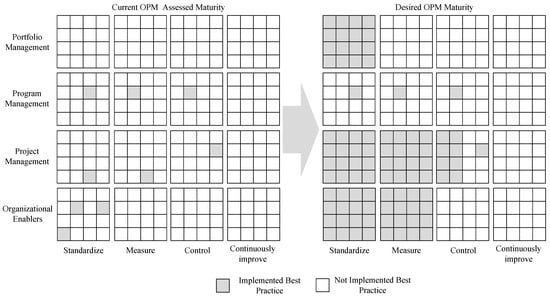
Figure 3.
Assessment of current and desired maturity level according to OPM3.
2.3. The International Project Management Association Delta (IPMADELTA®)
The IPMA Delta® Project Excellence Model was developed in 2009 by the International Project Management Association (Bushuyev and Wagner 2014). The IPMA DELTA® model is based on international competency requirements for specialists, projects and organizations. To assess the level of maturity of project management, three modules were distinguished:
- Module Individuals—I. Within the framework of this module, the competencies of the key performers are assessed: project, program and portfolio managers, project participants, stakeholders, administrators, etc. Both professional competencies and knowledge competencies are assessed. These competencies are assessed using the IPMA Individual Competence Baseline (ICB).
- Module Projects—P. Within the framework of this module, project activities are directly assessed. The focus of the evaluation is on results, methods and tools. The IPMA Project Excellence Baseline® (PEB) is used to assess project management competence.
- Module Organization—O. Within the framework of this module, the competence of project management is assessed from the perspective of the organization, namely, how much the CEO is involved in project processes, what is the integral benefit of the organization from the project’s implementation, etc. To assess the organization’s competence, the IPMA Organization Competence Baseline (OCB) rules are used.
There are five levels of maturity in IPMA Delta® (Figure 4):
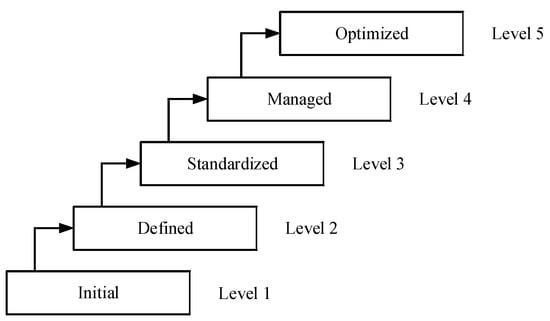
Figure 4.
Maturity levels according to IPMA DELTA®.
- Level 1. Initial—the level is characterized by singular achievements in the field of project management. There is no single standard for the work of personnel, which is why some employees work efficiently, some work unsatisfactorily.
- Level 2. Defined—the level is characterized by the presence of certain standards for managing projects, programs and project portfolios, however, management structures and processes are used non-systemically.
- Level 3. Standardized—the level is characterized by the incomplete and non-integrated application of management processes, structures and standards.
- Level 4. Managed—the level is characterized by the full and integrated operation of management-controlled standards, structures and processes of management.
- Level 5. Optimized—the level is characterized by the full, controlled and constantly improving functioning of all necessary standards, structures and management processes.
2.4. The Portfolio, Program and Project Management Maturity Model (P3M3®)
The OGC Portfolio, Program and Project Management Maturity Model (P3M3®) was developed in 2003 by the Office of Government Commerce (OGC). P3M3® is based on the PRINCE2® project management methodology and includes (PRINCE2® 2017):
- Project Management Maturity Model (PfM3);
- Programme Management Maturity Model (PgM3);
- Project Management Maturity Model (PjM3).
Based on PRINCE2®, simplified P3M3® maturity models have also been developed:
- PRINCE2 Maturity Model (P2MM);
- Project Management Maturity Model (P1M3);
- Programme and Project Management Maturity Model (P2M3).
The P3M3® model includes five levels of project management maturity (Figure 5):
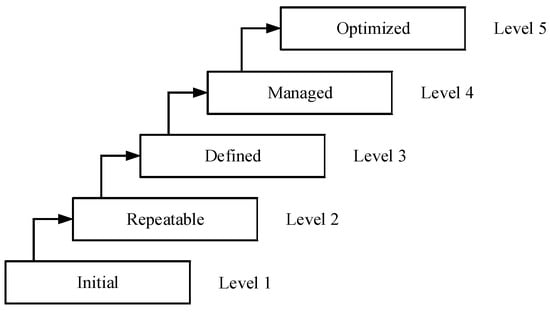
Figure 5.
Maturity levels according to P3M3®.
- Level 1. Initial—projects are managed without standardized procedures and control systems.
- Level 2. Repeatable—organization implements projects on its own resources. Minimal process standardization is used.
- Level 3. Defined—organization has its own project management processes that do not change.
- Level 4. Managed—the organization has specific management metrics for all projects that are suitable for predicting the future state.
- Level 5. Optimized—the organization is in a continuous process of improving project management using a proactive approach.
2.5. The Software Process Improvement and Capability Evaluation (SPICE)
By the acronym SPICE, two different models for assessing and improving managerial maturity are known. The first, Structured/Standardized Process Improvement for Construction Enterprises, was created in the University of Salford with funding from the UK Department of Environment, Transport and the Regions in 2000. It has gained some notoriety in the construction and infrastructure management sectors of the organization.
However, the best-known model is SPICE, that created as a series of ISO/IEC 15504 and 330(XX) standards. At the time of creation, the abbreviation SPICE meant Software Process Improvement and Capability Evaluation, but soon the name changed into Software Process Improvement and Capability Etermination. The project was initiated in 1993 and the first standard in the ISO/IEC 15504 series was published in 1998. The development of SPICE was largely motivated by the success of CMM/CMMI, and both models evidently influenced each other.
Similar to CMMI, ISO/IEC 15504 proposes assessing process capability (ISO 15504-2) and organizational maturity (ISO 15504-7) separately. Specific processes are not introduced in the standard; instead, reference is made to the ISO/IEC 12207 standard, which defines life cycle processes. Process capabilities are rated on a scale of 0 to 5:
- Level 0. Incomplete—where the process is not implemented or could not reach its destination.
- Level 1. Performed—where the process has somehow reached its destination.
- Level 2. Managed—where the process is managed (planned, regulated, monitored) and its work products are properly installed, controlled and maintained.
- Level 3. Established—where the process is carried out using certain methods and infrastructure that allow achieving the desired outputs.
- Level 4. Predictable—where quantitative goals for the implementation of the process are set, the results of measuring the degree of goals achievement are collected and analyzed.
- Level 5. Optimized—where the process is improved continuously to achieve relevant current and planned business goals.
The ISO/IEC TR 15504-7 standard appeared in 2008. It set up six levels of organizational maturity:
- Level 0. Immature.
- Level 1. Basic.
- Level 2. Managed.
- Level 3. Established.
- Level 4. Predictable.
- Level 5. Innovating.
In 2009, it was decided to replace the ISO/IEC 15504 series of standards with the new ISO/IEC 330(XX) series from 33001 to 33099. The first standard of the new series—ISO/IEC TR 33014:2013—was released in 2013, and another six standards (33001, 33002, 33003, 33004, 33020, 33063) were released in 2015. The new series was a development of the previous one and can be considered as a further definition of the SPICE model.
The new version introduced six levels of process abilities (Figure 6):
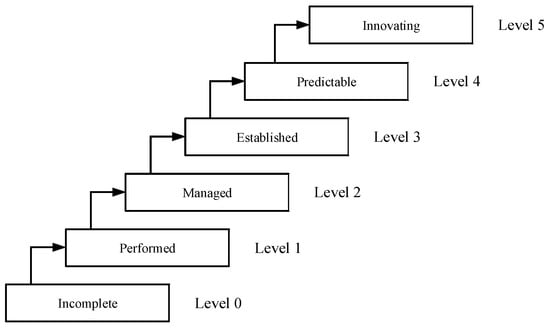
Figure 6.
Maturity levels according to SPICE.
- Level 0. Incomplete—the process is not implemented or does not meet its goal.
- Level 1. Performed—the process achieves its goal.
- Level 2. Managed—the process is planned, monitored and corrected; the results of its work are established, monitored and updated accordingly.
- Level 3. Established—the process is implemented on the base of methods and infrastructure; thus, it could bring appropriate results.
- Level 4. Predictable—the process is carried out in a predictable manner within specified limits in order to achieve the desired results. To achieve this goal, quantitative control parameters are identified, measurement data is collected and analyzed in order to identify and explain the causes of discrepancies, and corrective actions are taken to work out the causes of discrepancies.
- Level 5. Innovating—the process is continuously improved to reflect ongoing changes in accordance with the organization’s business goals.
2.6. The Project Management Process Maturity Model (PM2)
The Project Management Process Maturity Model (PM2) was developed by Y. H. Kwak and C. W. Ibbs 1997 (Kwak and Ibbs 2002). The model was revised and expanded in 2002. PM2 is based on the international set of PMBOK® Guide project management rules, namely the areas of project management knowledge.
The model is the basis for assessing and determining the current levels of maturity of project management in the organization and illustrates steps to improve the efficiency of project management (Ibbs and Kwak 1997). PM2 separates project management processes and practices, allowing to identify strengths and weaknesses of project management and focus on weaknesses to achieve a higher maturity level. The model provides a systematic and step-by-step approach to increase the maturity of project management in an organization using five levels (Figure 7):
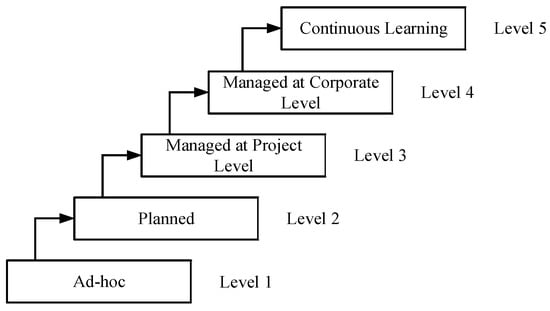
Figure 7.
Maturity levels according to PM2.
- Level 1. Ad hoc—main project management processes.
- Level 2. Planned—individual project planning.
- Level 3. Managed at Project Level—systematic planning and monitoring of the project.
- Level 4. Managed at Corporate Level—integrated multi project planning and monitoring.
- Level 5. Continuous Learning—continuous improvement of project management processes.
2.7. The Kerzner Project Management Maturity Model (PMMM)
The Kerzner Project Management Maturity Model (PMMM) was developed by H. Kerzner (The Kerzner Approach®) in 2001 (Kerzner 2001). According to Kerzner, achieving exceptional project management results requires a certain level of maturity (Figure 8):
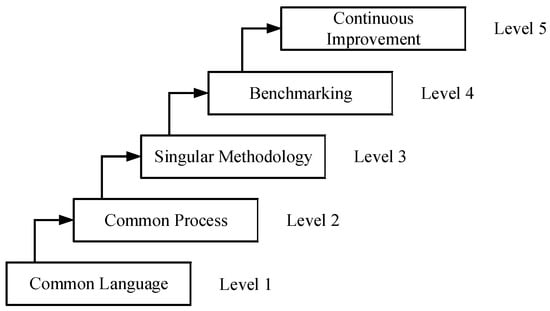
Figure 8.
Maturity levels according to PMMM.
- Level 1. Common Language—the organization recognizes the importance of project management and the need to master the basic knowledge of project management. Employees of the organization learn the terminology and language of project management.
- Level 2. Common Process—the organization recognizes the importance of defining and developing common processes so that the success of one project can be replicated by others.
- Level 3. Singular Methodology—the organization recognizes the importance of synergy in bringing all the methodologies used in the corporation into one where project management gains central significance.
- Level 4. Benchmarking—there is an awareness that it is necessary to improve corporate processes if the organization wants to maintain its position. Benchmarking is carried out continuously.
- Level 5. Continuous Improvement—at this level, the organization evaluates the information obtained in the course of benchmarking and uses this information to develop a unified methodology.
2.8. The Project Management Maturity Model (ProMMM)
The Project Management Maturity Model (ProMMM) was developed by D. Hilson in 2003 (Hillson 2003). The concept of a maturity model is based on benchmarking, i.e., on the process of identifying and adapting existing examples of the effective functioning of an organization. Benchmarking includes evaluation and comparison processes. The structure of ProMMM was taken from such models as the Capability Maturity Model (CMM) and Excellence Model from the European Foundation for Quality Management (EFQM 1999). The ProMMM model includes the following levels (Figure 9):
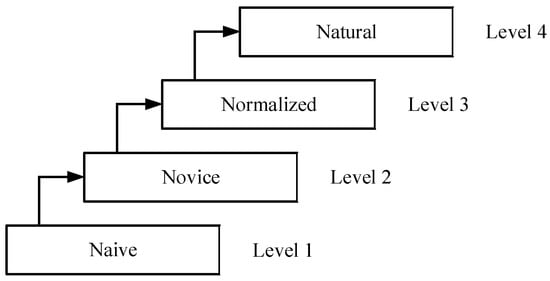
Figure 9.
Maturity levels according to ProMMM.
- Level 1. Naive—the organization does not know the cost of using the project activities. There is no project management structure. Insufficient attention is paid to possible threats.
- Level 2. Novice—the organization begins to experiment with project management, but the main processes are not formal, although the financial benefits of using project activities are much greater than at Level 1.
- Level 3. Normalized—at this level, project activities directly affect the organization’s business activities. All key management processes are formalized.
- Level 4. Natural—at this level, the organization has a developed corporate culture based on the best practices.
2.9. The PM Solutions Project Management Maturity Model (PMMMsm)
The PM Solutions Project Management Maturity Model (PMMMsm) was developed by PM Solution and J. K. Crawford in 2007 (Crawford 2007). The PMMMsm model is based on the international project management body of knowledge PMBOK® Guide, in particular on project management knowledge areas. Through research, Crawford found that the best project management practices described in the PMBOK® Guide can be fully implemented and at the proper quality level only by “heroic” project managers. Among the main reasons Crawford identifies:
- Lack of management tools prioritization in the PMBOK® Guide. From each area of expertise, project managers are given multiple approaches, methods and tools that blur their focus.
- PMBOK® Guide equally evaluates the importance of knowledge areas and their information content. Crawford subdivides knowledge areas into core areas (content management, cost, schedule, quality) that make the greatest contribution to the successful completion of projects and auxiliary areas (communications, risk, resource management, etc.).
- New project managers need at least 10–15 years of continuous practice to reach the level of “heroic” project managers.
On this base, the concept of a gradual transition from “immature” management in knowledge areas to “mature” management was proposed and divided into five levels (Figure 10):
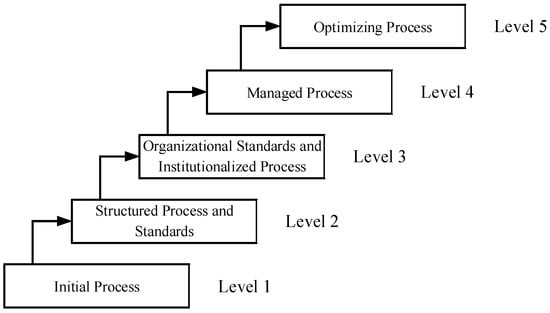
Figure 10.
Maturity levels according to PMMMsm.
- Level 1. Initial Process—there are no established standards in project management. Project documents are drawn up freely and one-time-only. Measuring the effectiveness and efficiency of design work is carried out spontaneously. Each member of the project team can define the concept of “project”, but these definitions will not coincide with each other.
- Level 2. Structured Process and Standards—management is based on the best practices, but they are not fixed at the level of organization standards. The management of the organization supports the development of project management but does not provide consistent and systematic work in this regard. There are no people responsible for improvements. Metrics have been developed to track project cost, schedule and labor productivity, but the data is collected and processed manually.
- Level 3. Organizational Standards and Institutionalized Process—all project processes are anchored in the internal standards of the organization. Clients and end users are active and integral members of the project team. All projects use the same management standards. The organization’s management regularly reviews proposals to improve internal standards.
- Level 4. Managed Process—project management is based on the past experience and lessons learned. Project information is integrated with the organization’s corporate systems. The management of the organization is clearly aware of its role in the field of project management. Internal standards are differentiated by types, sizes and complexity of projects.
- Level 5. Optimizing Process—project management activities are continuously improving. Experience is drawn from each new situation and used to improve project management processes, standards and project documentation.
3. Analysis of Strengths and Weaknesses of Maturity Models
The conducted research made it possible to critically examine the nine most popular project management maturity models in the world. The identified strengths and weaknesses of the most popular maturity models are presented in Table 1. The results of a comparative analysis of the most popular maturity models are presented in Appendix A.

Table 1.
Strengths and weaknesses of maturity models.
It should be noted that the authors of this article conducted the research in terms of identifying empirical evidence that clearly shows the positive effects for an organization when moving from one level of maturity to another, in addition to a critical analysis of strengths, weaknesses and a comparative analysis. In particular:
- A. F. Bay and M. Skitmore review the application of the PMMM model in Indonesia (Bay and Skitmore 2006). Their research involved 143 respondents who believed that a high level of maturity is necessary for suppliers and contractors (69%), business consultants (57%), investment companies (72%), manufacturing (75%), service industries (42%) and financial institutions (40%). Respondents note that if the maturity level of organizations that are engaged in these sectors of the economy is low, then they will be exposed to numerous risks.
- A.V. Polkovnikov and O. N. Ilina in their study use the PMMM model to determine the maturity level in Russian organizations (Polkovnikov and Ilina 2014). The study involved 140 organizations. According to the results, there are no level 4 and level 5 organizations among the respondents. The remaining organizations were distributed in the following proportions: Level 1—58 organizations, Level 2—57 organizations, Level 3—25 organizations.
- C. Demir and I. Kocabas describe the application of the PMMM model for educational institutions in Turkey (Demir and Kocabas 2010). According to the results of the study, Level 4 and Level 5 are elusive goals for educational institutions. However, it should be noted that these claims are not empirically supported.
- D. Ofori and E. W. Deffor reviewed the PMMM model in Ghana (Ofori and Deffor 2013). More than 200 respondents took part in the survey. Respondents believe that a high maturity level is very important for private organizations, government organizations and non-profit organizations. Research in Ghana has shown that the majority of private and public organizations have an average maturity level (Level 2 and Level 3).
- K. P. Grant and J. S. Pennypacker use the PMMMsm model in their studies. The study involved 126 respondents located in North America. According to the studies, Level 1 includes 13.7%, Level 2—53.2%, Level 3—19.4%, Level 4—7.3% and Level 5—6.5%.
As the analysis has shown, in general, scientists refer only to the identification of maturity levels in organizations and do not consider such important questions as: “Is there an increase in profit when the level of maturity increases?”, “How does the likelihood of project success changes with the maturity level increase?” and “What are the problems in moving an organization from one level to another?”.
4. Conclusions
After a critical analysis of the most popular project management maturity models, the authors of the article made the following conclusions:
- The most developed models are based on international project management codes of knowledge (ISO, PMBOK® Guide, PMCD, PRINCE2®, etc.), which is a significant advantage for maturity models such as OPM3, IPMA DELTA®, P3M3® and PMMMsm.
- The majority of maturity models do not take into account the presence of structural and infrastructural elements, such as a workplace, the necessary equipment and software, the availability of professional standards, instructions, regulations, etc. Project activities are often viewed from the perspective of an organization, but the work of project managers, project participants teams and project business processes are overlooked.
- There are no processes for evaluating the effectiveness and efficiency of using the best practices. As a rule, maturity models are not aimed at identifying the best management practices, which, generally, are developed by the organization in the process of implementing projects and solving problems that arise in the process of implementation.
- The considered models do not take into account the influence of corporate culture (except for the ProMMM model). It is worth noting that the corporate culture of an organization can both stimulate the improvement of project management, and, on the contrary, contribute to its deterioration.
- The maturity models developers in sufficient depth and detail describe the processes, technologies, competencies, documents, etc., that should be present at the lowest maturity levels. However, as soon as it comes to a higher maturity level, the authors tend to describe only the conceptual content. This may indicate that there is no practical content for the upper levels.
- Thus, based on the analysis of the nine most popular project management maturity models, it can be concluded that contractors (performers, suppliers) with a high level of project management maturity ensure the successful achievement of planned goals due to the high maturity of employees, the availability of necessary processes, quality documents, a developed corporate culture of project management based on the best group and individual practices, as well as mechanisms that eliminate the materialization of universal and special risks (Nikolaenko and Sidorov 2023). In this regard, it is logical to assume that the project management maturity assessment is a tool for identifying the best contractor (performer, supplier) who can guarantee the creation of the desired product, successfully complete any project and faithfully fulfill all obligations under the contract.
Author Contributions
Conceptualization, V.N. and A.S.; methodology, V.N.; validation, V.N.; formal analysis, V.N. and A.S.; investigation, V.N.; resources, V.N. and A.S.; data curation, V.N.; writing—original draft preparation, V.N. and A.S.; writing—review and editing, V.N. and A.S.; visualization, V.N.; supervision, A.S.; project administration, A.S.; funding acquisition, A.S. All authors have read and agreed to the published version of the manuscript.
Funding
This research was funded by Ministry of Science and Higher Education; project FEWM-2023-0013.
Data Availability Statement
Not applicable.
Conflicts of Interest
The authors declare no conflict of interest.
Appendix A

Table A1.
Comparative analysis of the most popular maturity models.
Table A1.
Comparative analysis of the most popular maturity models.
| Criterion | Name of Project Management Maturity Model | ||||||||
|---|---|---|---|---|---|---|---|---|---|
| CMMI® | OPM3 | IPMA DELTA® | P3M3® | SPICE | PM2 | PMMM | ProMMM | PMMMsm | |
| Developer | SEI | PMI | IPMA | OGC | ISO | Kwak Y.H. и Ibbs C.W. | Kerzner H. | HilsonD. | PM Solution Crawford K.J. |
| Suitable for evaluation | Yes | Yes | Yes | Yes | Yes | Yes | Yes | Yes | Yes |
| Suitable for analysis of strengths and weaknesses | Yes | Yes | Yes | Yes | Yes | Yes | Yes | Yes | Yes |
| Suitable for project management improvement | Yes | Yes | Yes | Yes | Yes | Yes | Yes | Yes | Yes |
| Sector | IT | For all sectors | For all sectors | For all sectors | IT, auto, space, medicine | For all sectors | For all sectors | For all sectors | For all sectors |
| Process reference model | Yes, 22 processes | No | No | Yes, 32 processes | No | No | No | No | No |
| Knowledge domain reference model | No | No | Yes, ICB, contains 46 elements of competence | No | No | Yes, 9 fields of knowledge | No | No | Yes, 10 fields of knowledge |
| Reference model for the best management practices | No | Yes, 586 best practices and 2400 abilities for projects, programs and portfolios | No | No | No | No | No | No | No |
| Number of maturity levels | 1–3 | 0–1 (presence or lack of the best practice) | 1–5 | 1–5 | 0–5 | 1–5 | 1–5 | 1–4 | 1–5 |
| Based on a body of knowledge of the project management best practices | – | PMBOK® Guide The Standard for Program Management, The Standard for Portfolio Management, PMCD | ICB, OCB, PEB | PRINCE2® | ISO standarts | PMBOK® Guide | — | — | PMBOK® Guide |
| Creation date of the first version | 2000 | 2003 | ICB (1999) | 2003 | 1998 | 1997 | 2001 | 2003 | 2007 |
| Creation date of the latest version | 2018 | 2013 | ICB (2015), OCB (2016), PEB (2016) | 2006 | 2015 | 2002 | — | — | 2015 |
| The process of determining the maturity level of project management is described | Yes | Yes | Yes | Yes | Yes | Yes | Yes | Yes | Yes |
| The process of determining the maturity level of program management is described | No | Yes | No | Yes | No | No | No | No | No |
| The process of determining the maturity level of portfolio is described management | No | Yes | No | Yes | No | No | No | No | No |
| Certification | Yes Class A, B and C | No | Yes Level A, B, C and D | Yes | Yes | No | No | No | Yes |
References
- Andersen, Erling Sverdrup, and Svein Arne Jessen. 2003. Project maturity in organizations. International Journal of Project Management Accounting 21: 457–61. [Google Scholar]
- Backlund, Fredrick, Diana Chronéer, and Erik Sundqvist. 2014. Project management maturity models–A critical review: A case study within Swedish engineering and construction organizations. Procedia Social and Behavioral Sciences 119: 837–46. [Google Scholar] [CrossRef]
- Bay, Achmad Fuad, and Martin Skitmore. 2006. Project Management Maturity: Some Results from Indonesia. Journal of Building and Construction Management 10: 2–15. [Google Scholar]
- Bushuyev, Sergey, and Reinhard Friedrich Wagner. 2014. IPMA Delta® and IPMA Organisational Competence Baseline (OCB): New approaches in the field of project management maturity. International Journal of Managing Projects in Business 7: 302–10. [Google Scholar] [CrossRef]
- Crawford, James Kent. 2007. Project Management Maturity Model. New York: Auerbach Publications. [Google Scholar]
- Demir, Canan, and İbrahim Kocabaş. 2010. Project Management Maturity Model (PMMM) in educational organizations. Procedia Social and Behavioral Sciences 9: 1641–45. [Google Scholar] [CrossRef]
- EFQM. 1999. The EFQM Excellence Model. Brussels: European Foundation for Quality Management (EFQM). [Google Scholar]
- Grant, Kevin, and James Pennypacker. 2006. Project management maturity: An assessment of project management capabilities among and between selected industries. IEEE Transactions on Engineering Management 53: 59–68. [Google Scholar] [CrossRef]
- Hillson, David. 2003. Assessing organisational project management capability. Journal of Facilities Management 2: 298–311. [Google Scholar] [CrossRef]
- Ibbs, William, and Young-Hoon Kwak. 1997. The Benefits of Project Management—Financial and Organizational Rewards to Corporations. Newtown Square: Project Management Institute. [Google Scholar]
- ICB IPMA. 2015. Individual Competence Baseline for Project, Programme & Portfolio Management (ICB IPMA). Version 4.0. Zurich: International Project Management Association. [Google Scholar]
- ISO. 2018. ISO 31000:2018 Risk Management—Guidelines. Geneva: International Organization for Standardization. [Google Scholar]
- Jugdev, Kam, and Janice Thomas. 2002. Project Management Maturity Models: The Silver Bullets of Competitive Advantage? Project Management Journal 33: 4–14. [Google Scholar] [CrossRef]
- Kerzner, Harold. 2001. Strategic Planning for Project Management: Using a Project Management Maturity Model. Hoboken: John Wiley & Sons. [Google Scholar]
- Khoshgoftar, Mohammad, and Omar Osman. 2009. Comparison of Maturity Models. Proceedings of the 2009 2nd IEEE International Conference on Computer Science and Information Technology, Beijing, China, August 8–11; pp. 953–64. [Google Scholar]
- Kwak, Young Hoon, and William Ibbs. 2002. Project Management Process Maturity (PM)2 Model. Journal of Management in Engineering 18: 150–55. [Google Scholar] [CrossRef]
- Meisner, Remco. 2007. MINCE—A Framework for Organizational Maturity. Zaltbommel: Van Haren Publishing. [Google Scholar]
- Montero, Guillermo. 2013. Analysis of Common Maturity Models Applied to Project Management. In Book of Proceedings of the 7th International Conference on Industrial Engineering and Industrial Management XVII Congreso de Ingeniería de Organización. Valladolid: Universidad de Valladolid, pp. 788–94. [Google Scholar]
- Nikolaenko, Valentin. 2018. Negative and Positive Risks in IT-Projects. Moscow: Moscow University Bulletin, Series 21. Public Administration; vol. 3, pp. 91–124. [Google Scholar]
- Nikolaenko, Valentin. 2022. With the hope of taking a risk. A new approach to project management is proposed. Search 30–31: 4–5. [Google Scholar]
- Nikolaenko, Valentin, and Anatoly Sidorov. 2023. Analysis of 105 IT Project Risks. Journal of Risk and Financial Management 16: 33. [Google Scholar] [CrossRef]
- O’Neill, D. 2018. The Way Forward: A Strategy for Harmonizing Agile and CMMI. Cross Talk. The Journal of Defense Software Engineering 29: 4–9. [Google Scholar]
- Ofori, Dan, and Eric Worlanyo Deffor. 2013. Assessing Project Management Maturity in Africa: A Ghanaian Perspective. International Journal of Business Administration 4: 41–61. [Google Scholar] [CrossRef]
- Organizational Project Management Maturity Model (OPM3). 2013. Knowledge Foundation. Newtown Square: Project Management Institute. [Google Scholar]
- PMBOK Guide®. 2017. Project Management Body of Knowledge (PMBOK Guide®). Guide 6th edition. Newtown Square: Project Management Institute. [Google Scholar]
- Polkovnikov, Alexei, and Olga Ilina. 2014. The Reality of Project Management Practice in Russia: Study Results. Procedia Social and Behavioral Sciences 119: 805–10. [Google Scholar] [CrossRef]
- PRINCE2®. 2017. Managing Successful Project with PRINCE2 (PRINCE2®). London: The Stationery Office. [Google Scholar]
- Sidorov, Anatoly, and Pavel Senchenko. 2020. Regional Digital Economy: Assessment of Development Levels. Mathematics 8: 2143. [Google Scholar] [CrossRef]
- The CHAOS Manifesto. 2014. The Standish Group. Boston: The CHAOS Manifesto. [Google Scholar]
- Trocki, Michał, and Emil Bukłaha. 2016. Project Management—Challenges and Research Results. Warsaw: Warsaw Schools of Economics Press. [Google Scholar]
Disclaimer/Publisher’s Note: The statements, opinions and data contained in all publications are solely those of the individual author(s) and contributor(s) and not of MDPI and/or the editor(s). MDPI and/or the editor(s) disclaim responsibility for any injury to people or property resulting from any ideas, methods, instructions or products referred to in the content. |
© 2023 by the authors. Licensee MDPI, Basel, Switzerland. This article is an open access article distributed under the terms and conditions of the Creative Commons Attribution (CC BY) license (https://creativecommons.org/licenses/by/4.0/).